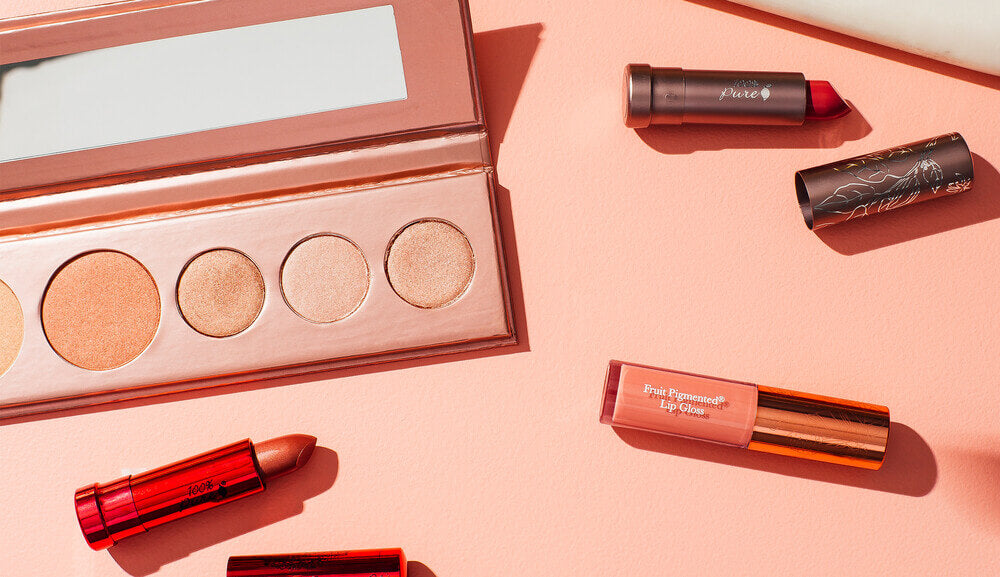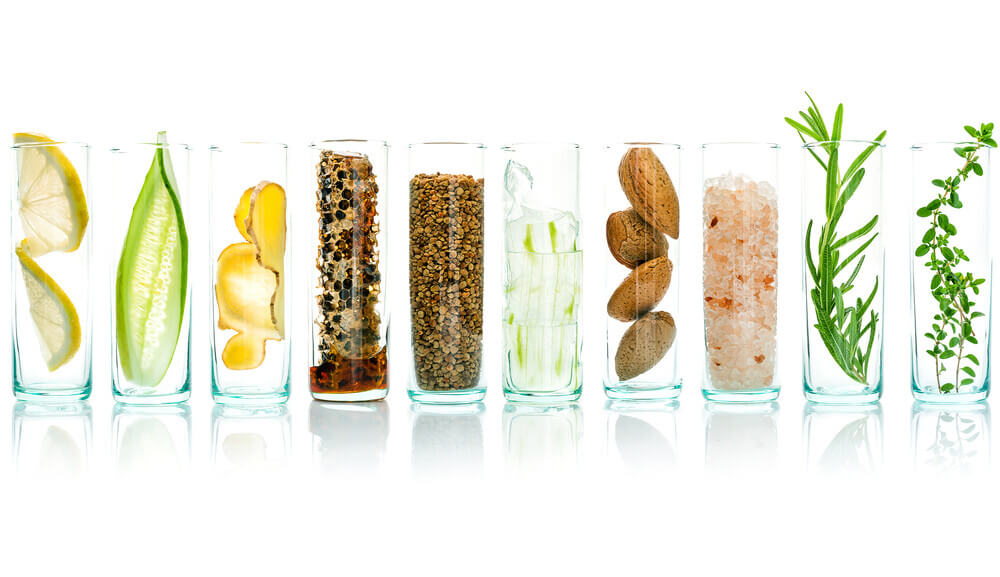Exploring the intersection of past and present innovations
Written by: 100% PURE®
The market for “clean makeup” is becoming more accessible. It’s a surreal sight for those who, just a few years ago, struggled to find makeup that was vegan or cruelty-free.
It’s exciting to see a growing demand for clean makeup but for some, clean makeup is… confusing. One might wonder: is clean makeup the same as “natural” makeup? Is clean makeup the new “natural makeup?”
The current assumption is that “clean” makeup has replaced “natural” makeup as the best option in ethical beauty. But don’t be so quick to jump on the ‘clean’ bandwagon – it’s not accurate to say “clean” is the new “natural”, especially when natural ingredients are still so relevant!
In this article, we’re talking about the difference between “clean makeup” and “natural makeup”, how they intersect, and where we stand on the matter here at 100% PURE.

Let’s talk about clean makeup.
Before we dive in, it’s important to make something clear here: while the term “clean” is becoming more widely used by beauty and wellness brands, there is no universal definition behind it, and no certifying standard for the term. And because there’s no regulated standard, any brand can technically claim to be “clean”.
However, there are brands who genuinely care about setting a standard. So what does “clean” mean to them?
Each brand might have different specifications, but generally speaking, “clean” makeup is created with a consideration for our bodies and the environment. This means that the brand uses transparent, cruelty-free practices, and there’s a strong emphasis on ingredients and their sourcing.
Typically, these ingredients are either sustainably sourced from the earth, or expertly synthesized in a lab (more on this later).
Clean makeup brands will also make strides to avoid any potentially harmful ingredients, like the following:
- parabens
- pesticides
- phthalates
- potential hormone disruptors (i.e.,triclosan)
- allergens (i.e., hydroquinone)
- environmental toxins (i.e., chemical sunscreens)
- potential carcinogens (i.e., formaldehyde)
As brands have evolved under the nuances of “clean” makeup, the clean beauty movement has become a way for brands to explore and innovate, creating new formulas with safe, non-toxic synthetic ingredients.
So, if clean makeup is all about safe, responsible ingredients, does that make “clean makeup” and “natural makeup” the same?
Not quite. While these two terms are often associated with each other, there are some key differences. So what does “natural” mean?
Just as with “clean” makeup, there is no standardized definition for “natural makeup”.
However, it’s generally accepted that natural makeup uses ingredients that are sourced directly from nature, like coconut oil or aloe vera. And while “natural” was once the big buzzword alongside “green” and “eco-friendly”, it’s become less frequently used. There are a few reasons why.
The big one is that pretty much any product can be loosely marketed as “natural”. For instance, most products contain, to some degree, water – which is technically a natural ingredient. On top of that, stressing the importance of “natural” makeup implies that synthetic ingredients are inherently bad, and this isn’t necessarily true!
To be clear, synthetic ingredients are man-made, and not directly taken from nature. They may be taken from a petrochemical such as an oil or gas, or they can be derived from a natural feedstock, such as a plant or mineral.
While of course many dangerous ingredients (like parabens) are synthetic, there are dangerous natural ingredients, too!
For instance, poison ivy or deadly nightshade are natural and from the earth, but that doesn’t mean they should be in our makeup. Likewise, there are synthetic ingredients that are not only safe for humans, but can even make a better alternative to “natural” sources.
And let’s be clear: “natural” can mean animal-derived, and these animals may be harmed or killed. For instance, squalene has been a popular ingredient in makeup for many years. With a consistency that’s similar to sebum, squalene is known to blend seamlessly into the skin without caking or melting off.
However, squalene is taken from sharks, who are poached for their liver to harvest this ingredient. This type of poaching has led to a number of issues in shark populations, which can affect all types of ocean life.
Luckily, scientists now know how to create squalane, which behaves just like squalene, except it’s more stable and it’s derived from olives and rice bran instead. So does this mean that “natural” makeup is actually not so great? Or that we should completely disregard it?
Absolutely not!
There’s a wealth of natural ingredients that can be ethically sourced and do wonders for our skin. And many brands would consider “natural” ingredients to be a cornerstone of clean makeup.
So let’s explore the intersection of “clean” makeup and “natural” makeup.
Newsletter Subscribe
for more blog updates and exclusive discounts

So what does makeup look like when it’s natural and clean?
When shopping for natural makeup, you’re going to (hopefully) encounter brands that value transparency, and offer an explanation on how their products are manufactured and obtained.
You should also see ingredients that are sustainably sourced from nature; either directly, or through minimal processing and extraction. And when a makeup brand is both clean and natural, these ingredients should be vegan whenever possible.
For example, niacinamide can be found in meat, poultry and fish, but it can also come from vegetables, beans and grains. Plant-based pigments are also a great example, like blackberries and cherries, which offer beautiful coloring without posing a health threat or harming any animals.
As we can see, clean makeup has an emphasis on being gentle on skin. But some ingredients can go above and beyond, with nutrients that can actually help makeup act like skin care. White tea is an excellent source of antioxidants, which help fight signs of aging by neutralizing free radicals. Red raspberry oil can gently soften the skin and reduce inflammation.
In the space where clean makeup is also natural, we’re seeing formulas more beneficial to our skin and the planet than ever before.
At 100% PURE, it’s no secret that we’re obsessed with kind, gentle ingredients from nature. But where do we fall on the spectrum? Are we a natural makeup brand, or a clean makeup brand?
As a brand that was founded in 2004, we were very much born from the “natural” ideal. In fact, we were creating makeup with natural ingredients when that was just becoming the norm!
And in the interest of the planet and our customers, we’ve come to incorporate more “clean” ingredients into our products. This is how we expand on innovations that aren’t quite possible with a fully nature-derived formula, using clean synthetic ingredients to offer safer alternatives to common toxins.
It’s always been our intention to create safe, sustainable makeup. But as our understanding of formulations has evolved, we’ve become more aware of our relationship with the earth and its creatures, and what we can do as a brand to support it.
Is clean makeup better for your skin than natural makeup?
While clean makeup can be a better option for some individuals, it ultimately depends on your skin type and sensitivities. Clean makeup typically avoids common irritants and harsh chemicals, which can be beneficial for people with sensitive or reactive skin. However, it’s important to note that even natural or clean ingredients can cause skin reactions in some individuals. It’s always a good idea to patch test products and choose makeup that suits your specific skin needs.
Are clean makeup products free from all synthetic ingredients?
Clean makeup products strive to minimize or avoid the use of synthetic ingredients, but it does not necessarily mean that they’re entirely free from them. Clean makeup brands typically prioritize using natural, organic, or plant-based ingredients, and they avoid potentially harmful synthetic chemicals such as parabens, sulfates, phthalates, and synthetic fragrances. However, some clean makeup products may still contain certain ingredients that are considered safe or have a low risk profile.
Does 'clean' mean the same as 'organic' or 'vegan' in makeup terminology?
No, clean does not mean the same as ‘organic’ or ‘vegan’ in makeup terminology. While these terms are sometimes used interchangeably, they have different meanings.
- Clean makeup: Clean makeup focuses on using ingredients that are considered safe for human health and often avoids potentially harmful chemicals. It prioritizes transparancy and ethical sourcing.
- Organic makeup: organic makeup refers to products made from ingredients that have been grown without the use of synthetic pesticides, herbicides, or genetically modified organisms (GMOs). Organic certification standards vary by country, but they generally require a certain percentage of organic ingredients in the product.
- Vegan makeup: Vegan makeup products do not contain any animal-derived ingredients or by-products. They are cruelty-free and not tested on animals. However, vegan makeup products may still contain synthetic or chemical ingredients.
Is clean makeup more environmentally friendly than traditional makeup?
Clean makeup brands often prioritize sustainability and environmentally friendly practices, but it’s not a guarantee that all clean makeup products are more environmentally friendly than traditional makeup. While clean makeup brands may use sustainable packaging, responsibly sourced ingredients, and eco-friendly manufacturing processes, it’s important to consider the overall lifecycle of a product to determine its environmental impact. Factors such as ingredient sourcing, manufacturing practices, packaging materials, transportation, and product disposal all play a role in a product’s environmental footprint.
Can clean makeup products deliver the same results as conventional makeup products?
Clean makeup products have come a long way in terms of performance and quality, and many brands now offer a wide range of options that can deliver similar results to conventional makeup products. However, it’s important to note that the effectiveness and results may vary depending on the specific product, brand, and individual preferences. Some clean makeup products may have limitations in terms of longevity, coverage, or certain finishes compared to their conventional counterparts. It’s a matter of personal preference and finding the right clean makeup products that suit your needs and desired outcomes.
We carefully hand-select products based on strict purity standards, and only recommend products we feel meet this criteria. 100% PURE™ may earn a small commission for products purchased through affiliate links.
The information in this article is for educational use, and not intended to substitute professional medical advice, diagnosis, or treatment and should not be used as such.

